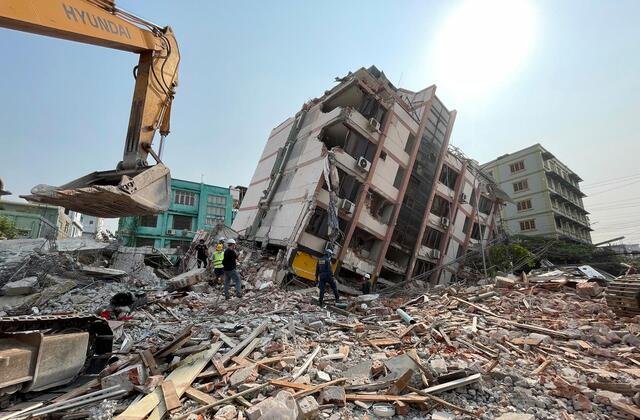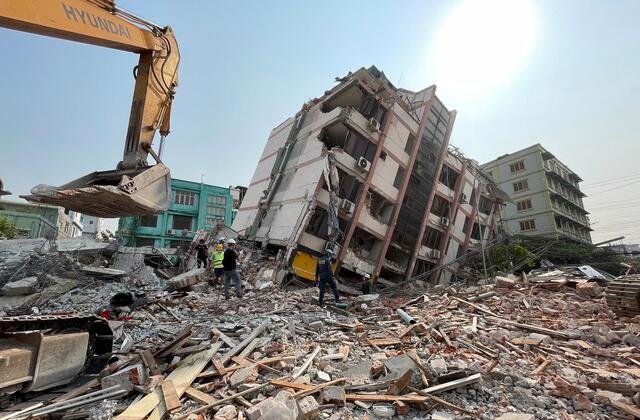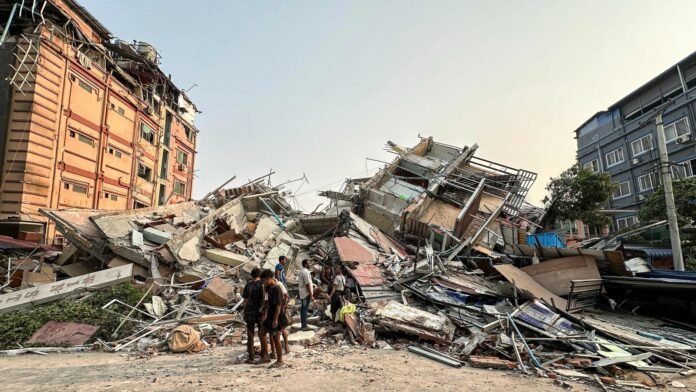A catastrophic Myanmar Earthquake has left the nation reeling, with the death toll exceeding 2,000 and thousands more injured. The massive 7.7-magnitude earthquake struck near Mandalay, Myanmar’s second-largest city, causing extensive destruction and triggering an urgent need for humanitarian aid. Rescue teams are racing against time to locate survivors amid the rubble, but hopes are fading as days pass.
Unprecedented Impact of the Myanmar Earthquake
The Myanmar Earthquake hit during midday, leading to widespread panic as buildings crumbled and infrastructure collapsed. The quake’s intensity was felt across neighboring countries, with tremors reported in India, Bangladesh, Thailand, and China.
Casualties and Missing Persons
- The confirmed death toll has risen to over 2,000 with numbers expected to climb as rescue efforts continue.
- More than 3,900 people have sustained severe injuries, overwhelming Myanmar’s already fragile healthcare system.
- At least 270 individuals remain missing, with families desperately searching through debris for their loved ones.
- Among the deceased are foreign nationals from China and France, further highlighting the quake’s extensive reach.

Rescue and Relief Operations Amid Challenges
Following the Myanmar Earthquake, local and international relief teams are working tirelessly to provide assistance. However, multiple challenges hinder their efforts:
1. Destruction of Critical Infrastructure
- Roads, bridges, and hospitals in affected regions have suffered massive damage, making it difficult to transport medical aid and supplies.
- Power outages and disrupted communication networks have further complicated coordination efforts.
2. Limited Access to Affected Areas
- Myanmar’s ongoing political crisis and civil unrest have created obstacles in distributing aid to remote and conflict-affected regions.
- International relief agencies have requested unrestricted access, but logistical challenges remain.
3. Food, Water, and Shelter Shortages
- Thousands of survivors are struggling with severe shortages of clean water, food, and medical aid.
- Temporary shelters are overcrowded, increasing concerns of disease outbreaks in the aftermath of the disaster.
International Response and Aid Efforts
The Myanmar Earthquake has prompted global humanitarian responses, with several countries stepping in to provide aid:
- India launched “Operation Brahma”, sending medical teams and relief supplies to assist affected regions.
- China dispatched emergency response teams, delivering medical aid and food provisions.
- The United Nations and WHO are mobilizing resources to address urgent healthcare and shelter needs.
Despite these efforts, aid distribution remains slow due to the extensive damage and ongoing internal conflict.

Survivors’ Struggles and Growing Fears
In the wake of the Myanmar Earthquake, thousands of displaced families face uncertainty. Many have been forced to sleep outdoors due to the risk of aftershocks and unstable buildings.
Survivors describe harrowing experiences of digging through rubble with bare hands in search of missing loved ones. Some villages remain completely cut off, with no access to emergency assistance.
The psychological toll is immense, as families mourn their losses while bracing for potential aftershocks.
Will Myanmar Recover from the Earthquake?
The road to recovery after the Myanmar Earthquake will be long and challenging. Experts predict that rebuilding efforts could take years, given the extent of the destruction. Key priorities moving forward include:
- Providing immediate medical care for the injured.
- Rebuilding infrastructure to restore essential services.
- Ensuring safe and efficient distribution of humanitarian aid.
The international community continues to call for swift and effective relief efforts to prevent further loss of life.
The Myanmar Earthquake has left a deep humanitarian crisis in its wake, with the death toll rising and survivors struggling to access basic necessities. While international aid is trickling in, challenges remain in reaching all affected areas. As the world watches, the urgency for coordinated relief efforts grows, ensuring that those impacted by this devastating natural disaster receive the help they desperately need.
Also Read: Shillong Businessman Died by Suicide at Umiam Dam Bridge, Investigation Underway












